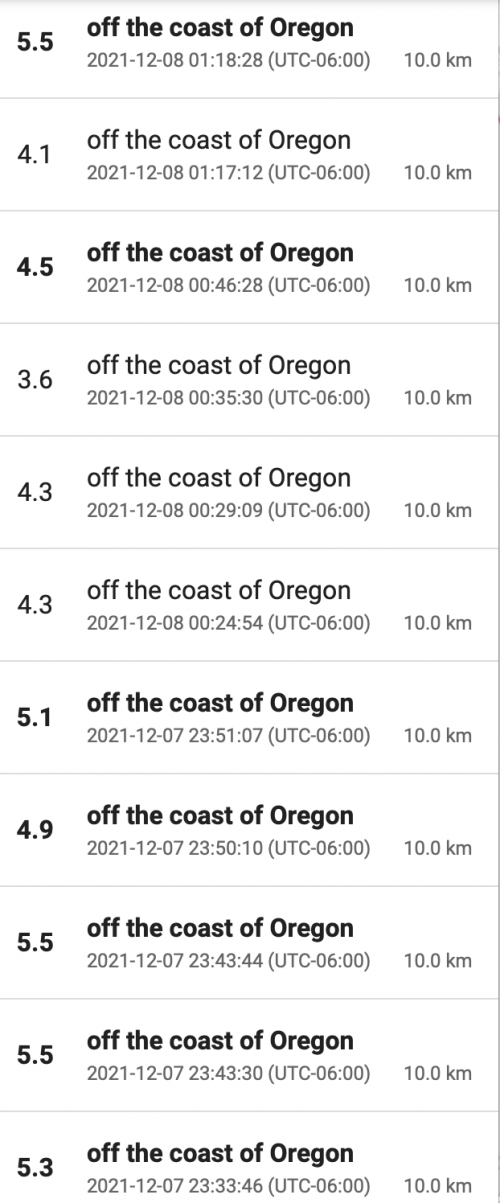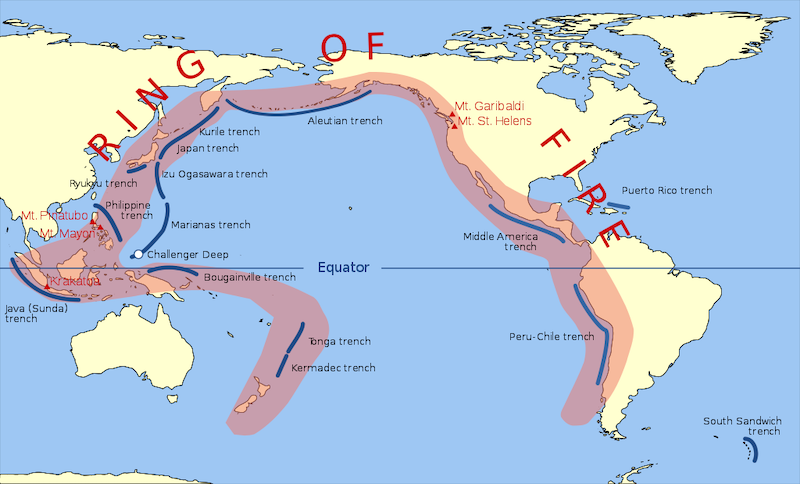
Dozens of earthquakes
The U.S. Geological Survey (USGS) is reporting dozens of small-to-moderate earthquakes that started yesterday (December 7, 2021) and continued through this morning, off the coast of the U.S. state of Oregon. The largest reached magnitude 5.8, according to USGS. Earthquakes in the ocean sometimes cause tsunamis. But no tsunamis were ever expected from these earthquakes, and none are expected at this writing.
Earthquakes often happen in a series, although it’s unusual to see so many earthquakes (at least 40 by my count) as in this series. They’re of special interest because they’re happening off the coast of a heavily populated region. We often see a dozen or so foreshocks and aftershocks around a primary earthquake. The small-to-moderate quakes off the Oregon coast on December 7-8, 2021, can be considered foreshocks and aftershocks of each other. The terms are relative. It’ll be easiest to sort out which are foreshocks and which are aftershocks (and which are both) once the earthquake series has stopped.
Has it stopped? The last earthquake as of this writing took place less than an hour ago, at 10:50 UTC this morning, December 8. That is 4:50 a.m. CST; translate UTC to your time. It was a 5.2-magnitude quake. So it’s unknown yet how many more earthquakes might occur in the Pacific, off the Oregon coast, today.

EarthSky 2022 lunar calendars now available! They make great gifts. Order now. Going fast!
Earthquakes happen every day
As of this writing, USGS is showing 80 earthquakes – all around the globe – over the past 24 hours. More than 40 of them happened off the coast of Oregon.
Earthquakes are common in this part of the world, because western North America borders what’s called the Ring of Fire, the most seismically and volcanically active zone in the world. The Ring of Fire is a horseshoe-shaped swath – 24,900 miles (40,000 km) long – dotted with seismically active locations. Over 80 per cent of large earthquakes occur along the Ring of Fire, where the Pacific plate is being subducted beneath the surrounding plates.

Pressure building, pressure releasing
In a way, an earthquake series like this can be seen as a release of the pressure that’s been building between land plates along this region of the Ring of Fire. Better a lot of little earthquakes than one big one. OregonLive.com said:
Small earthquakes strike often near Oregon’s coast, a regular reminder of the cataclysmic earthquake geologists say will happen when the pressure building between the Juan de Fuca and North American plates breaks.
Per Oregon officials, scientists say there is a 37% chance that a 7.1 magnitude or higher earthquake will happen at the boundary between the two tectonic plates, called the Cascadia Subduction Zone, in the next 50 years.
Bottom line: The USGS Latest Earthquakes page is displaying more than 40 small-to-moderate earthquakes on December 7 and 8, 2021, off the coast of Oregon.
Go to the USGS Latest Earthquakes page
The post Dozens of earthquakes rumble off the Oregon coast first appeared on EarthSky.
from EarthSky https://ift.tt/3GpcKZB

Dozens of earthquakes
The U.S. Geological Survey (USGS) is reporting dozens of small-to-moderate earthquakes that started yesterday (December 7, 2021) and continued through this morning, off the coast of the U.S. state of Oregon. The largest reached magnitude 5.8, according to USGS. Earthquakes in the ocean sometimes cause tsunamis. But no tsunamis were ever expected from these earthquakes, and none are expected at this writing.
Earthquakes often happen in a series, although it’s unusual to see so many earthquakes (at least 40 by my count) as in this series. They’re of special interest because they’re happening off the coast of a heavily populated region. We often see a dozen or so foreshocks and aftershocks around a primary earthquake. The small-to-moderate quakes off the Oregon coast on December 7-8, 2021, can be considered foreshocks and aftershocks of each other. The terms are relative. It’ll be easiest to sort out which are foreshocks and which are aftershocks (and which are both) once the earthquake series has stopped.
Has it stopped? The last earthquake as of this writing took place less than an hour ago, at 10:50 UTC this morning, December 8. That is 4:50 a.m. CST; translate UTC to your time. It was a 5.2-magnitude quake. So it’s unknown yet how many more earthquakes might occur in the Pacific, off the Oregon coast, today.

EarthSky 2022 lunar calendars now available! They make great gifts. Order now. Going fast!
Earthquakes happen every day
As of this writing, USGS is showing 80 earthquakes – all around the globe – over the past 24 hours. More than 40 of them happened off the coast of Oregon.
Earthquakes are common in this part of the world, because western North America borders what’s called the Ring of Fire, the most seismically and volcanically active zone in the world. The Ring of Fire is a horseshoe-shaped swath – 24,900 miles (40,000 km) long – dotted with seismically active locations. Over 80 per cent of large earthquakes occur along the Ring of Fire, where the Pacific plate is being subducted beneath the surrounding plates.

Pressure building, pressure releasing
In a way, an earthquake series like this can be seen as a release of the pressure that’s been building between land plates along this region of the Ring of Fire. Better a lot of little earthquakes than one big one. OregonLive.com said:
Small earthquakes strike often near Oregon’s coast, a regular reminder of the cataclysmic earthquake geologists say will happen when the pressure building between the Juan de Fuca and North American plates breaks.
Per Oregon officials, scientists say there is a 37% chance that a 7.1 magnitude or higher earthquake will happen at the boundary between the two tectonic plates, called the Cascadia Subduction Zone, in the next 50 years.
Bottom line: The USGS Latest Earthquakes page is displaying more than 40 small-to-moderate earthquakes on December 7 and 8, 2021, off the coast of Oregon.
Go to the USGS Latest Earthquakes page
The post Dozens of earthquakes rumble off the Oregon coast first appeared on EarthSky.
from EarthSky https://ift.tt/3GpcKZB

Aucun commentaire:
Enregistrer un commentaire